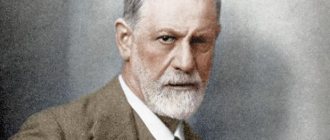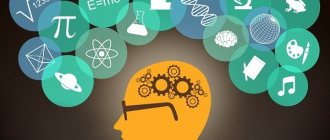Memory is one of the mental processes in the human body, thanks to which information is accumulated, studied and remembered. Thanks to this concept, we can talk about the development of experience and the ability of the brain to recreate remembered elements at the right time.
Memory influences emotions and feelings, developing a person’s reactions to the environment, forming values and life position. The process can be divided into two components:
- Life experiences that reflect how the world has shaped a person.
- Personal observations and experiences.
Information can be stored in several “buffers”, depending on how it was received, what emotions and memories accompanied the person at that moment.
Types of memory
Psychologists identify several subtypes, each of which cannot exist separately, but is directly related to the others.
These are complex brain functions that scientists and doctors have been studying for centuries. Now in the mental system there is:
| Memory type | a brief description of |
| Sensory | Instant imprint of information and facts on the peripheral parts of the analyzers. Can be divided into iconic and echoic memory. |
| Short-term | A work process during which only a small part of the entire semantic flow is absorbed. In order for the volume to be large, it is necessary to train the sensory organs. |
| Secondary | Memory is based on personal experience and experienced emotions. Moments associated with certain sensations are remembered. It is divided into declarative and procedural processes. |
| Memory for distant events | The ability to remember certain facts and events on a subconscious level. The same emotions as at the moment of remembering will help to evoke memories in the future. The process is spontaneous and is not completely controlled by a person. It can be either short-term or long-term. |
Storing information is possible due to the use of different types of memorization. Thanks to analyzers on the temporal lobes of the cerebral cortex, processes of renewal and repetition of what has already been seen or heard occur.
A close connection with neurons allows not only to reproduce information, but also to convey an emotional background. There are several mechanisms for retrieving information from memory.
Memory, causes of its disorders, and methods of memory training
- home
- For patients
- Articles
- Memory, causes of its disorders, and methods of memory training
»
»
»
Memory is a mental property of a person, the ability to accumulate (memorize), store and reproduce experience and information. Memory is the ability to remember individual experiences from the past, being aware not only of the experience itself, but of its place in the history of our life, its placement in time and space. Memory is difficult to reduce to one concept. But let us emphasize that memory is a set of processes and functions that expand a person’s cognitive capabilities. Memory covers all the impressions that a person has about the world around him. Memory is a complex structure of several functions or processes that ensure the recording of a person’s past experiences. Memory can be defined as a psychological process that performs the functions of remembering, preserving and reproducing material. The three functions mentioned are the main ones for memory.
Another important fact: memory stores and restores very different elements of our experience: intellectual, emotional and motor-motor. Memory of feelings and emotions can last even longer than intellectual memory of specific events.
The most important features, integral characteristics of memory are duration, speed, accuracy, readiness, volume (memorization and reproduction) . How productive a person’s memory is depends on these characteristics.
1. Volume - the ability to simultaneously store a significant amount of information. The average memory capacity is 7 elements (units) of information. 2. The speed of memorization varies from person to person. The speed of memorization can be increased with the help of special memory training. 3. Accuracy is reflected in the recall of facts and events that a person has encountered, as well as in the recall of the content of information. This trait is very important in learning. 4. Duration – the ability to preserve the experience for a long time. A very individual quality: some people can remember the faces and names of school friends after many years (long-term memory is developed), some forget them after just a few years. The duration of memory is selective. 5. Readiness for reproduction - the ability to quickly reproduce information in the human mind. It is thanks to this ability that we can effectively use previously acquired experience.
Types and forms of memory
There are different classifications of types of human memory: 1. According to the participation of the will in the process of memorization. 2. By mental activity, which predominates in the activity. 3. By the duration of information storage. 4. The essence of the subject and method of memorization. 5. By the nature of the participation of the will. 6. Based on the nature of the target activity, memory is divided into involuntary and voluntary. 1) Involuntary memory means remembering and reproducing automatically, without any effort. 2) Voluntary memory refers to cases where a specific task is present and volitional efforts are used to remember. It has been proven that material that is interesting to a person, that is important, that is of great importance is involuntarily remembered.
According to the nature of mental activity with the help of which a person remembers information, memory is divided into motor, emotional (affective), figurative and verbal-logical.
1. Motor (kinetic) memory is memorization and preservation, and, if necessary, reproduction of diverse, complex movements. This memory is actively involved in the development of motor (labor, sports) skills and abilities. All manual movements of a person are associated with this type of memory. This memory manifests itself in a person first, and is extremely necessary for the normal development of a child.
2. Emotional memory – memory of experiences. This type of memory is especially evident in human relationships. As a rule, what causes emotional experiences in a person is remembered by him without much difficulty and for a long time. It has been proven that there is a connection between the pleasantness of an experience and how it is retained in memory. Pleasant experiences are retained much better than unpleasant ones. Human memory is generally optimistic by nature. It is human nature to forget unpleasant things; Memories of terrible tragedies, over time, lose their sharpness. This type of memory plays an important role in human motivation, and this memory manifests itself very early: in infancy (about 6 months).
3. Figurative memory - associated with remembering and reproducing sensory images of objects and phenomena, their properties, and relationships between them. This memory begins to manifest itself by the age of 2 years, and reaches its highest point by adolescence. Images can be different: a person remembers both images of various objects and a general idea of them, with some abstract content. In turn, figurative memory is divided according to the type of analyzers that are involved in memorizing impressions by a person. Figurative memory can be visual, auditory, olfactory, tactile and gustatory.
Different people have more active different analyzers, but most people have better developed visual memory . Visual memory is associated with the storage and reproduction of visual images. People with developed visual memory usually have a well-developed imagination and are able to “see” information even when it no longer affects the senses. Visual memory is very important for people in certain professions: artists, engineers, designers. The previously mentioned eidetic vision, or phenomenal memory, is also characterized by a rich imagination and an abundance of images. Auditory memory is a good memorization and accurate reproduction of various sounds : speech, music. Such memory is especially necessary when studying foreign languages, musicians, and composers. Tactile, olfactory and gustatory memory are examples of memory (there are other types that will not be mentioned) that do not play a significant role in human life, since the capabilities of such memory are very limited and its role is to satisfy the biological needs of the body. These types of memory develop especially acutely in people of certain professions, as well as in special life circumstances (classic examples: people born blind and deaf-blind).
4. Verbal-logical memory is a type of memorization when the word, thought, and logic play a large role in the memorization process. In this case, a person tries to understand the information being acquired, clarify the terminology, establish all the semantic connections in the text, and only after that remember the material. It is easier for people with developed verbal-logical memory to remember verbal, abstract material, concepts, and formulas. This type of memory, in combination with auditory memory, is possessed by scientists, as well as experienced lecturers, university teachers, etc. Logical memory, when trained, gives very good results and is more effective than simple mechanical memorization. Some researchers believe that this memory is formed and begins to “work” later than other types. P. P. Blonsky called it “memory-story.” A child already has it at 3-4 years old, when the very foundations of logic begin to develop. The development of logical memory occurs with the child’s learning the basics of science.
According to the duration of information retention: 1) Instant or iconic memory This memory retains material that was just received by the senses, without any processing of information. The duration of this memory is from 0.1 to 0.5 s. Often, in this case, a person remembers information without conscious effort, even against his will. This is a memory-image. A person perceives electromagnetic vibrations, changes in air pressure, changes in the position of an object in space, giving them a certain meaning. A stimulus always carries certain information that is specific only to it. The physical parameters of the stimulus affecting the receptor in the sensory system are converted into certain states of the central nervous system (CNS). Establishing a correspondence between the physical parameters of a stimulus and the state of the central nervous system is impossible without memory work. This memory manifests itself in children even in preschool age, but over the years its importance for a person increases. 2) Short-term memory Storing information for a short period of time: on average about 20 s. This type of memorization can occur after a single or very brief perception. This memory works without conscious effort to remember, but with the intention of future reproduction. The most essential elements of the perceived image are stored in memory. Short-term memory “turns on” when the so-called actual consciousness of a person operates (i.e., what is realized by a person and somehow correlates with his current interests and needs).
Information is entered into short-term memory by paying attention to it. For example: a person who has seen his wristwatch hundreds of times may not answer the question: “Which numeral - Roman or Arabic - represents the number six on the watch?” He never purposefully perceived this fact and, thus, the information was not deposited in short-term memory. The capacity of short-term memory is very individual, and there are developed formulas and methods for measuring it. In this regard, it is necessary to talk about such a feature as the property of substitution. When an individual's memory capacity becomes full, new information partially replaces what is already stored there, and old information often disappears forever. A good example would be the difficulty in remembering the abundance of surnames and first names of people we have just met. A person is able to retain no more names in short-term memory than his individual memory capacity allows. By making a conscious effort, you can retain information in memory longer, which will ensure its transfer into working memory. This is the basis of remembering by repetition. In fact, short-term memory plays a vital role. Thanks to short-term memory, a huge amount of information is processed. The unnecessary is immediately eliminated and what is potentially useful remains. As a result, long-term memory does not become overloaded with unnecessary information. Short-term memory organizes a person’s thinking, since thinking “draws” information and facts from short-term and operative memory.
3) Random access memory is a memory designed to retain information for a certain, predetermined period. The storage period for information ranges from a few seconds to several days. After solving the task, information may disappear from RAM. A good example would be the information that a student is trying to absorb during an exam: the time frame and task are clearly defined. After passing the exam, there is again complete “amnesia” on this issue. This type of memory is, as it were, transitional from short-term to long-term, since it includes elements of both memory. 4) Long-term memory - memory that can store information for an unlimited period. This memory does not begin to function immediately after the material has been memorized, but after some time. A person must switch from one process to another: from memorization to reproduction. These two processes are incompatible and their mechanisms are completely different.
Interestingly, the more often information is reproduced, the more firmly it is fixed in memory. In other words, a person can recall information at any necessary moment through an effort of will. It is interesting to note that mental ability is not always an indicator of memory quality . For example, in mentally retarded people, phenomenal long-term memory is sometimes found . Why is the ability to retain information necessary to perceive information? This is due to two main reasons. Firstly, a person deals at each moment with only relatively small fragments of the external environment. In order to integrate these temporally separated influences into a holistic picture of the surrounding world, the effects of previous events when perceiving subsequent ones must be, so to speak, “at hand.” The second reason is related to the purposefulness of our behavior. The acquired experience must be remembered in such a way that it can be successfully used for the subsequent regulation of forms of behavior aimed at achieving similar goals. The information stored in a person’s memory is assessed by him from the point of view of its significance for controlling behavior and, in accordance with this assessment, is retained in varying degrees of readiness. Human memory is not in the least bit a passive repository of information—it is an active activity.
Most people periodically complain about their “girlish” memory. As a rule, they practically never part with their diaries, in which they carefully write down all their plans for the next day. However, difficulties lurk everywhere. Sometimes not being able to remember someone's name can be quite an awkward situation.
How to develop memory in an adult?
Forgetful people periodically ask themselves a similar question. And those who not only look for the answer, but also begin to implement all the recommendations in life, over time notice excellent results.
Causes of poor memory
As people age, their ability to remember deteriorates and they become distracted. A person needs to keep too much information in his head, which is why he sometimes forgets the most obvious facts. But it's not only that. The older a person gets, the worse his ability to reason sensibly becomes. The causes of poor memory in adults are hidden both in age-related changes and in poor lifestyle, stress, poor sleep and much more. There are fewer nerve cells, and at the same time it is increasingly difficult for a person to delve into something new. Poor memory in an adult can be a consequence of certain diseases. It is noted that the ability to remember, as well as thinking, is adversely affected by: high blood pressure; atherosclerosis; diabetes; completeness. Sometimes memory impairment can be a consequence of developing Alzheimer's disease.
Methods to improve memory
An amazing ability can be trained, like a body muscle. To do this, you need to do special memory exercises. For adults, of course, training will require some effort. After all, this happens most easily in childhood. Kids try to remember everything that catches their eye.
Memory exercises for adults
The load on a student’s memory is already quite significant. But when a person finishes studying and begins to work, his memory is no longer amenable to systematic training. Life becomes more boring and ordinary. In order for memory to continue to develop, a person must receive impressions. It’s good if various pleasant events happen and people try not to forget them.
Effect of tobacco
First of all, you need to get rid of the harmful effects of nicotine. Numerous studies have confirmed that tobacco significantly impairs the ability to remember. If you compare a person who trains his memory and at the same time smokes, and another who does not work on his ability to remember, but does not have a bad habit, it turns out that the first one has a better result. However, if their conditions are equalized, it turns out that tobacco still impairs memory. Studies have shown that students who smoke perform worse on tasks than non-smokers. Although tobacco has the ability to instantly increase concentration, this quickly passes.
Effect of alcohol
A flexible mind cannot be maintained by drinking alcoholic beverages. After all, they also weaken memory. Even a small dose of alcohol reduces the ability to remember. Its systematic use deprives a person of the opportunity to record something in memory. Therefore, those people who are thinking about how to develop memory in an adult should give up alcohol. methods for developing memory in adults It is recommended to exclude all types of alcohol before an important event where you need to remember something.
Medications
Taking certain medications can also affect memory and even cause memory loss. These include various sedatives or stimulants, as well as painkillers, antihistamines and anti-inflammatory drugs.
Basic recommendations
There are rules that allow the memory to always remain in working condition: enrich the blood with oxygen; be sure to get a good night's sleep; do not abuse alcohol and tobacco; refuse (if possible) medications that reduce memory.
Memorization techniques from geniuses
Psychologist Carl Seashore believes that the average person uses only 10% of his memory, while 90% remains unused. Few people know that almost all methods of memory development in adults are based on three natural laws of memorization. It's about emotions, associations and repetitions. Knowing these rules can help both in everyday life and in critical situations.
The law of emotions states that for better memorization it is enough to get vivid impressions of a given subject. The most famous person to use this rule was Roosevelt. He always maintained excellent concentration. Everything he read, he remembered almost word for word. The secret of this method of developing memory in adults is hidden in the need to fully concentrate, at least for a short time, on the necessary information. It is in this case that it will be remembered better than if you think about it for a long time and get distracted.
Napoleon left behind an amazing technique. During the troop review, he perfectly remembered the location of each of his soldiers and his last name. His secret to remembering a person's name was to get a more vivid impression of him. For example, asking how to spell his last name.
President Lincoln had his own method of memorization: he read aloud what was important to remember. It turns out that you need to use as many senses as possible. This makes it possible to quite effectively influence the development of memory in adults. Exercises that involve several senses are recommended by most psychologists. For example, to remember, it is enough to write down and then mentally imagine what was written.
Mark Twain often lectured. To remember long text, he wrote down a couple of words from the beginning of each paragraph. Before his speech, Twain repeated the entire lecture using this cheat sheet. But then another idea came to his mind - and he began to draw what he needed to remember. Thus, the geniuses of the past were able to embody all three laws of memorization.
How to develop memory in an adult: training exercises
Memory training in adults should begin with the following exercises: Keep your mind completely free of thoughts for 5-10 seconds. This is necessary for training concentration. During this process there should not be any tension: nervous or mental. From five seconds it is very important to gradually reach thirty seconds of continuous stay in this state. It is very important to develop not only visual or auditory memorization ability, but also other types. You also need to remember that short-term and long-term memory are equally necessary for a person.
Visual memory can be trained by trying to remember the appearance of people passing by . A fleeting glance at a person walking towards you is enough, and then you need to try to imagine his appearance in all details.
It is very useful to ask yourself from time to time what the wrapper of your favorite candy looks like and what is depicted there .
You can try to imagine what you saw when you passed the store again, what kind of sign there was. At the same time, you need to try to remember everything down to the smallest detail.
In order to improve sound memory , it is enough to regularly read aloud or learn poems with your child. Sing the melody you just listened to. In the street noise, try to hear fragments of phrases and fix them in memory.
When eating, imagine yourself as a taster who thoroughly remembers the taste of the dish . Associate each food with something. Play guessing the dish with your eyes closed.
At the perfume store, spray your favorite perfume onto a test strip. Then try to remember their name. Train with all the smells around you. You can start with simpler scents and then move on to more complex ones.
Try to develop your numerical memory . In order to remember the whole combination, you just need to throw away the calculator. To begin with, you can simply determine the change in the store for each purchase. Mental calculations greatly train memory associated with numbers. Try to determine the price for each product.
Count your steps, for example, from the entrance to the apartment to the elevator door. You can try to remember how many times you have to rotate the lamp in the socket before it is screwed in tightly enough. causes of poor memory in adults.
All types of memory are perfectly developed with the help of any types of board games. You can speed up your thinking processes with the help of chess and checkers, playing cards, and dominoes.
Solving crossword puzzles and all sorts of puzzles will help to train your memory perfectly
Origami improves rote memory. Various types of needlework, such as knitting, embroidery and drawing, improve fine motor skills and concentration on details.
If the effect of self-study is insufficient, you should contact a specialist: a neurologist or psychiatrist.
In addition, in Orenburg at the address: st. Proletarskaya, 153 there is a “School for Patients with Memory Problems”. Classes take place every second Wednesday of the month. Make an appointment by phone (3532) 40-20-11.
Everyone has memory. Some people simply have a phenomenal ability to remember. Others admit to having a “holey” head. According to psychologists, there are very few people with poor memory. At the same time, there are many who do not know how to use it correctly or do not know how to develop memory in an adult.
The article was prepared by a neurologist of the highest qualification category, S. A. Grankin.
When preparing the article, materials from the site were used: https://fb.ru/article/162910/kak-razvit-pamyat-u-vzroslogo-uprajneniya-dlya-trenirovki-obzor-luchshih-metodik-po-razvitiyu-pamyati https:// fb.ru/, Review of the best methods for memory development, Elena Biletskaya, December 29, 2014
Touch type
A type of memorization that is based on the influence of stimuli on the senses. Can be long-term if the irritants are strong. The process is not perceived separately from other types, because it combines the complex work of not only the cerebral cortex, but also the nervous system and the body as a whole.
A feature of the species is the ability to retain memories after the stimulation has stopped. Sensory memory is a complex process that facilitates the rapid acquisition of facts.
Between this and the short-term type of the described process there is an intermediate element - RAM. It allows you to perform an action or procedure on a mechanical level, without thinking about the details of execution. This sensory type of memory is associated with physical processes. As the work progresses, some elements may be forgotten. If information affects the cerebral cortex, then parts of operational memory become short-term.
There are several levels in the structure of the sensory view:
- Direct. This includes sensory memory, which consists of two additional elements.
- Short term.
- Long-term.
Regardless of what type of memory predominates in terms of perception and processing of information, it can be trained and the stock of facts can be increased. And drawing up the correct classification of the material allows you to quickly find what you need.
Iconic memorization
Types of sensory memory consist of visual and auditory memory. The first type is holistic portrait memorization and recording of information. Refers to long-term memory, since in the future images can serve as additional pointers for recreating a particular situation. The emotional background influences the iconic type.
In order to be able to accumulate new images and remember details, it is necessary to clear old emotions. Psychologists advise choosing for yourself a number of memories that cause unpleasant emotions or pity, and considering the reasons for their appearance, drawing conclusions and letting go of the situation. Along with the emotions, the images will also go away, thereby making room for new ones.
In the case of a high level of development of visual sensory memory, we can talk about the effect of reverse masking. The bottom line is that the codes of the image reach the cerebral cortex in a matter of milliseconds, and then in other images the person sees the features of the previous one.
This makes it possible to increase the amount of memorized information and constantly expand the boundaries of the visual field, because on a subconscious level the brain will “think out” the situation.
Echoic type
The basis of memorization is auditory perception of information. An effective technique, especially if there are no additional distracting elements. Unlike the visual type, there is no way to compare facts with images or emotions. Voice timbre, rhythm and strength are important for memorization. The ability to reproduce what was previously heard depends on the speed of information processing.
To enhance the memorization effect, scientists recommend accompanying the auditory type with tactile sensations so that information is connected with sensations. Data recording in this case will take place through the somatosensory system.
How not to forget
Sensory memory is the ability to remember a large amount of information through reference to the senses. But in the process of studying and processing, most of the facts are forgotten.
To prevent this from happening, psychologists advise sticking to simple but effective methods:
- Repetition. It is recommended to repeat new facts three to four times over several hours. It is important to switch to other points in the process and then return to the desired source again.
- Forgetting occurs faster in the first few days than in other periods. If you connect facts with images or emotions and remember them a week later, the information will be absorbed faster.
- Repeat before forgetting begins. It is much easier to retain information in your head if you concentrate on memorization in the first weeks.
- Associations. Drawing up a mental flow for the desired fact allows you to remember it for a long time. What kind of sensory memory is possible without visualizing imaginary images?
Performing simple actions will provide an opportunity not only to remember more, but also to learn how to systematize the acquired knowledge. Developing short-term sensory memory is an excellent opportunity to strengthen memory processes.
Short-term memory
Short-term memory, also called immediate or primary, serves to remember for a very short time. Its task is to repeat certain information (for example, a telephone number being dictated at the moment) and analyze it for further storage in long-term memory.
Its recording capabilities are very small. Without a strong-willed effort aimed at preserving information, it is lost. This practical memory is designed to instantly recall memories.
Accordingly, it has a limited volume (maximum seven to eight units) and limited storage time (at most two to three minutes). New information immediately displaces and replaces the old.
Main Factors
Sometimes it’s impossible to remember what you need, a person thinks about something else and cannot concentrate on the work of the brain. Psychologists identify several elements that influence the speed and quality of memorization. Sensory memory is a close relationship between the senses and operating factors:
- Mechanical and conscious memorization. The first option provides less benefit than the second. It is necessary to think about what needs to be remembered, to focus on details.
- Comparison. The process helps you focus on a specific image and highlight features.
- Systematization. When information relates to structure or type, it is much easier to master the volume through the desired category.
Memory training, using various techniques and focusing on details will help over time not only increase the ability to memorize, but also improve the quality of reproduction.
Development in children
A preschool child remembers all the information that comes to him mechanically; he does not make any effort to do so. This is what distinguishes him from teenagers and adults. In childhood, the child does not use memorization techniques that help increase memory capacity. By how quickly a child learns poetry or accurately retells a fairy tale he has heard, one judges the amount of memory gifted by nature.
Throughout a person’s life, long-term and short-term memory interact with each other, and the nature of these manipulations determines the ability to:
- remembering information;
- consolidation of knowledge;
- reproducing what is remembered.
If a child does not remember well, then such mental dysfunctions lead to the fact that he does not remember the teacher’s story, does not master school subjects well, and lags behind in his studies.
Thus, weak students do not always study poorly because of laziness or weak motivation. Some of them are simply unable to understand the subject because they have problems remembering.











